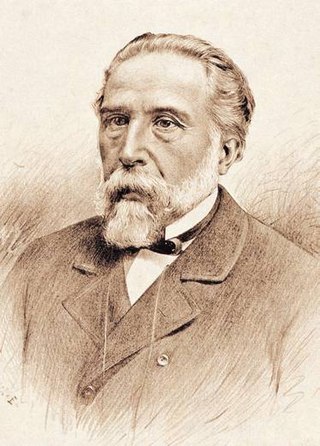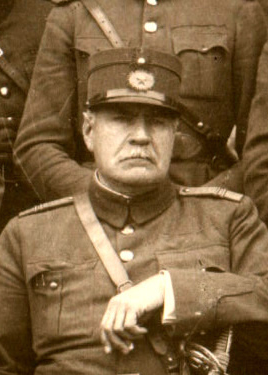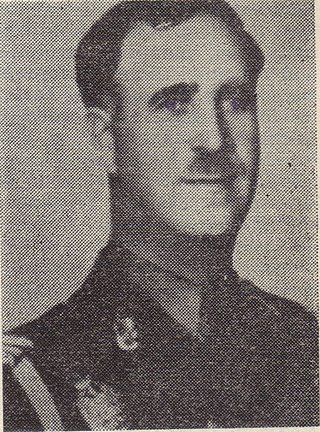
Ion Ghica was a Romanian statesman, mathematician, diplomat and politician, who was Prime Minister of Romania five times. He was a full member of the Romanian Academy and its president many times. He was the older brother and associate of Pantazi Ghica, a prolific writer and politician.

The Romanian Land Forces is the army of Romania, and the main component of the Romanian Armed Forces. Since 2007, full professionalization and a major equipment overhaul have transformed the nature of the Land Forces.

Io is the contraction of a title used mainly by the royalty in Moldavia and Wallachia, preceding their names and the complete list of titles. First used by the Asenid rulers of the Second Bulgarian Empire, the particle is the abbreviation of theophoric name Ioan (John), which comes from the original Hebrew Yohanan, meaning "God has favored". Io appeared in most documents, as issued by their respective chancelleries, since the countries' early history, but its frequency and relative importance among the princely attributes varied over time. Its usage probably dates back to the foundation of Wallachia, though it spread to Moldavia only in the 15th century. In more informal contexts, Romanians occasionally applied the title to benefactors or lieges from outiside the two countries, including John Hunyadi and George II Rákóczi.

The 8th Tactical Operational Missile Brigade, former 8th LAROM Brigade, is a Multiple Rocket Launcher brigade of the Romanian Land Forces. The brigade was named after the Romanian Domnitor Alexandru Ioan Cuza in 2006. It is the successor of three units: the 2nd Heavy Artillery Brigade, the 1st and 4th Heavy Artillery Regiments.

The colors of the national flag of Romania has a long history, though the association of the three colors only dates to the 18th century. Red, yellow and blue were found on late 16th-century royal grants of Michael the Brave, as well as shields and banners. Thus, the late 13th century Wijnbergen armorial shows the coat of arms of the Wallachian ruler Litovoi as consisting of a shield of ten vertically alternating gold-and-red bands,. The same two colors, gules and or, also appeared on the late 15th century flag and coat of arms of Moldavia, during the reign of Stephen the Great. Then, from the late 16th century until the mid-17th century, the historical coat of arms of Transylvania gradually developed as a shield party per fess, consisting of a black eagle on blue background in the upper field, a dividing red band in the middle, and seven red towers on golden background in the lower field. Finally, in the last quarter of the 18th century, Bukovina gets its own coat of arms from the Habsburg Empire, a blue-and-red shield party per pale with a black aurochs' head in the middle, and three golden six-pointed stars surrounding it. During the Wallachian uprising of 1821, these three colors were present, along others, on the canvas of the revolutionaries' flag and its fringes; for the first time a meaning was attributed to them: "Liberty (blue-sky), Justice, Fraternity ( blood)".

Aristide Razu, CB, was a Romanian divisional general, commander of the Romanian 22nd Infantry Division in the 1916 Romanian Campaign against the Central Powers, and of the Romanian 5th Infantry Division during the Battle of Mărășești, 6–19 August 1917, in World War I.
The current structure of the Romanian Land Forces is as follows:

The Michael the Brave 30th Guards Brigade is a primarily ceremonial, as well as combat unit of the Romanian Armed Forces established in 1990. The Brigade also has a military music band, a drill team detachment, and an artillery battery. The military police unit of the Brigade guards certain special objectives of Bucharest. The Brigade traces its origins to the 1st Tirailleur Battalion, later Vânători Battalion, which was established in 1860.

Ioan Popovici was a Romanian general and commander of the Romanian 1st Army Corps from 1916 to 1918 during World War I.

Ioan Popovici was a Romanian general assigned to the general staff headquarters, during World War I. He attended the Școala Militară de Infanterie și Cavalerie in Bucharest from 1885 to 1887. Afterward he rose through the ranks until he became a brigadier general in 1916 as World War I was raging, engulfing Romania. He was known as "Epure" to distinguish him from another Romanian general with the same name.

Alexandru A. Dobriceanu was an officer in the Romanian Army who fought in both World War I and World War II, and rose to the rank of major general afterwards.

Constantin Teodorescu was one of the generals of the Romanian Army in the First World War. He is most known for serving as division commander in the 1916 campaign.

Hermann Friedrich Staabs, von Staabs was a German infantry general in World War I and commanding general of the XXXIX. Reserve Corps.

Dumitru I. Cocorăscu was a Romanian general who was one of the generals of the Romanian Land Forces in World War I. He served as a brigade commander and division commander in the 1916 campaign.

Nicolae Sinescu (1865-1934) was one of the generals of the Romanian Land Forces in the First World War. He served as a cavalry division commander in the 1916 and 1917 campaigns.

Pirotehnia Armatei was the munitions factory of the Romanian Army. It was founded in Bucharest on 23 November 1861. In 1939 it was moved to Sadu (Bumbești-Jiu) where it continued to work as Pirotehnia Armatei Sadu until 1948. Today the factory is known as the Sadu Mechanical Plant. The former factory from Bucharest was eventually transformed into the "9 May" Plant in 1950, and was demolished in 2009.

The Army Arsenal of Bucharest was the main arsenal of the Romanian Army, established in 1861 with the task of manufacturing, maintaining, and storing weapons, as well as limbers and caissons for the artillery. The old flags, uniforms, and weapons of the Romanian Army were also stored at the Arsenal until 1919.

Initially established as the Army Foundry through a decree issued by Domnitor Alexandru Ioan Cuza in 1864, the Târgoviște Army Arsenal became an arsenal of the Romanian Army in 1872, being renamed as such in 1876. Between 1876 and 1935, it mainly functioned as a storage arsenal. During the Second World War, various weapons and equipment were repaired here.

The military of Wallachia existed throughout the history of the country. Starting from its founding to 1860, when it was united with the Moldavian army into what would become the Romanian Army.

The Dorobanți were a type of soldiers originating in the armies of Wallachia and Moldavia from the 16th century. They acted as both cavalry and infantry, and later also worked as a police force. From the late 19th century, the Dorobanți only acted as infantry, with the mounted Dorobanți being reorganized into Călărași units.




















